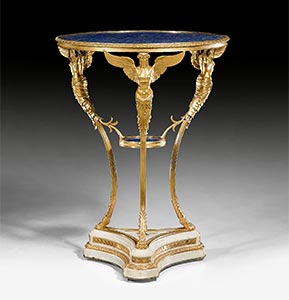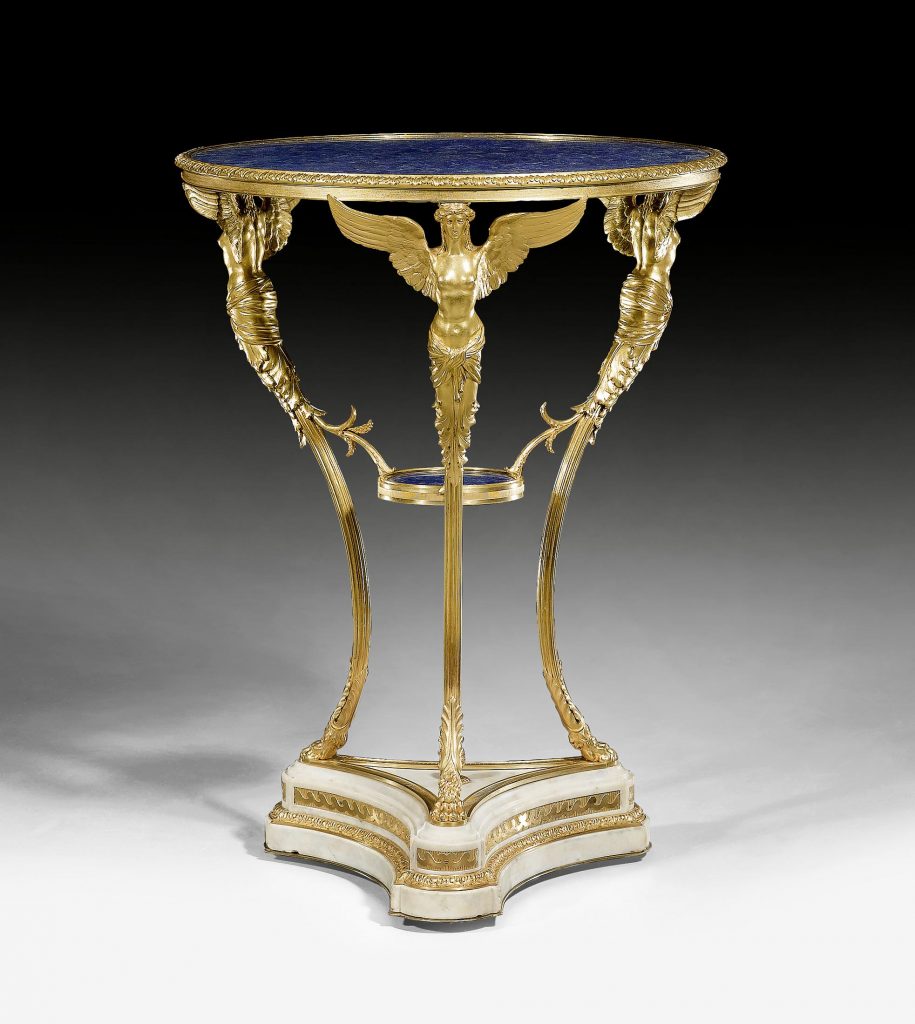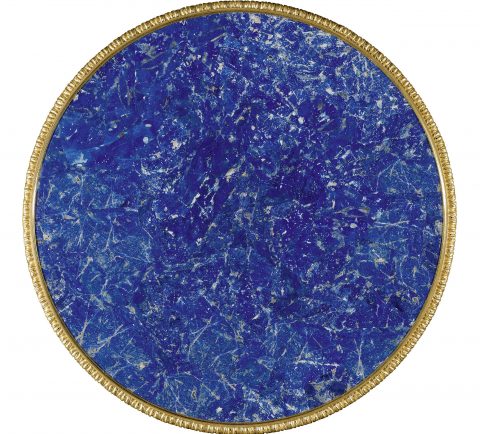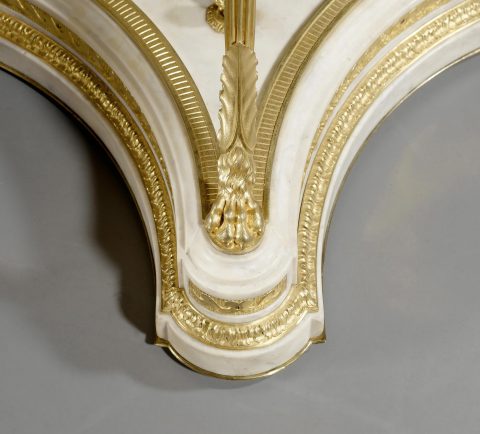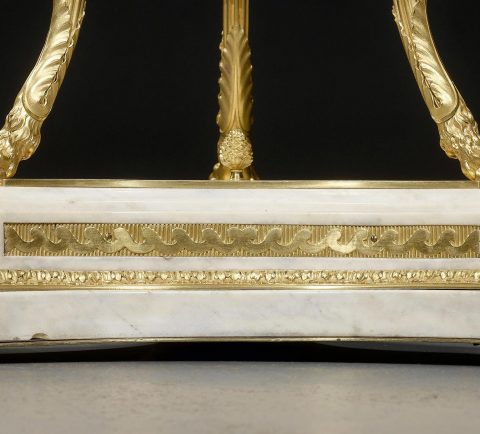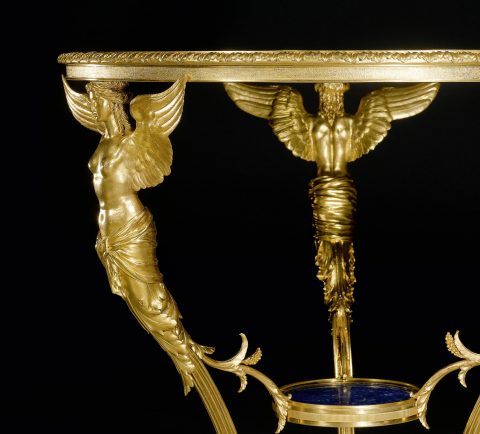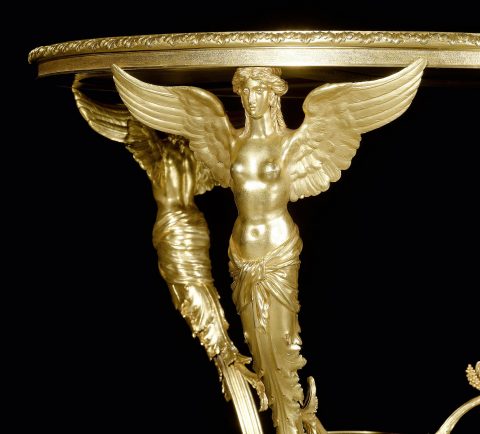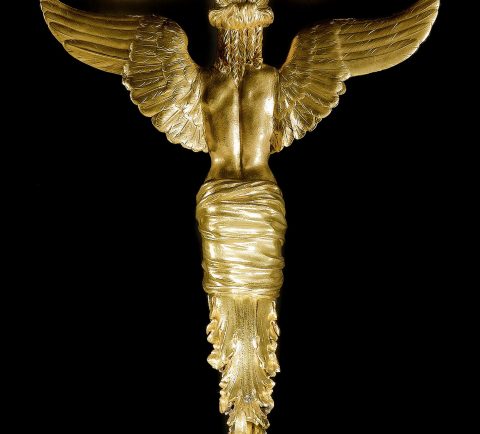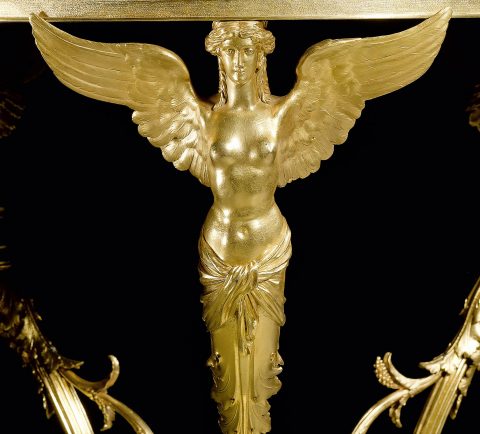A Russian ormolu and lapis lazuli Tripod Guéridon with caryatids
A Russian ormolu and lapis lazuli Tripod Guéridon with caryatids
St. Petersburg, ca 1790
Made by the Russian Imperial Workshop named the “Bronzespedition”, most probably designed by Vicenzo Brenna (Florence 1745 – 1820 Saint Petersburg).
Height 74.9 cm
Ø 55.8 cm
Expertise:
Prof. Dr. H. Ottomeyer, Berlin, February 2011
further illustrations
The history of the Russian ormolu and Lapis Lazuli Tripod Guéridon with caryatids
This pronk table derives from the rare type of the table en gueridon à l’antique, which is characterised by a second smaller tablar between the three monopodiae. It’s made in the style étrusque ou arabesque, a grotesque style, which appears in Europe between 1777 and 1800 declining to Romanesque examples showing motifs with chimeras. This style comes up first in Rome and spreads quickly over London (Robert Adam, Stuart, Revett) and Paris (Clérisseau, Bélanger, Dugourc) to Saint Petersburg (Cameron, Quarenghi, Brenna).
The gueridon stays on a heavy massive, ormolu-mounted base of white Carrara marble, a brass plate underneath with three ‘English rolls’; a unique construction of the 18th century to move the heavy table without lifting.
The top is made of a newly found sort of Russian lapis lazuli, also known as ‘Baikal lazurite’. The source is northeast from the Lake Baikal, the stone quarry existed since 1784 and the blue stone was grinded and polished since 1786 in the grinding mill of Kolyvan in the Altai-Mountains or since 1774 in the grinding mill of Yekaterinburg, both under the patronage of Catherine the Great.
Impressive is the fact that the diameter of the top with 55.8 cm corresponds exactly with 22 inches (1 inch = 2.54 cm). Under Zsar Peter the Great Russia adopted the English unit of measurement with foot and inch. The height of the gueridon with 74.9 cm corresponds with 29.5 inches, without the rolls 29 inches.
In 1770 the so-called Bronzespedition was founded in Saint Petersburg. The Italian architect Vicenzo Brenna was working there as designer and created the first tables with malachite tops in the grotesque style, ordered by Count Scheremetjew for the Ostankino Palace in 1770.
Very similar compositions can be found in the interior of Ostankino which decline to designs of Brenna and which are in the same style and with the same motifs like the present gueridon with caryatids.
Brenna came via Rome, where he studied with Quarenghi, to Warsaw. There he was commissioned by Stanislaus Potocki and participated in architectural works for the Royal Palace. Brenna worked for Crown Prince Paul in Pawlowsk and came in 1783/84 to Saint Petersburg. He was engaged for Paul in Pawlowsk until 1797 and for the Michaels Palace from 1796 to 1802. Commissions therefore were made over Martin-Eloi Lignereux in Paris. In 1802 Brenna retired with a pension from his royal orders and went to Dresden.
The present gueridon is an outstanding example for a Russian bronze-work made by the Imperial Workshop of Saint Petersburg about 1790, under the reign of Catherine the Great. Comparable bronzes combined with Russian Baikal lazurite can also be found in the so called lapis lazuli chamber of the Great Palace of Tsarskoje Selo near Saint Petersburg, an ultimate fact that embeds this outstanding combination with that place.
This highly precious piece of imperial meaning might have left the Tsardom as a diplomatic gift.
The present gueridon was examined by Prof. Dr. H. Ottomeyer, author of several standard works e.g. Ottomeyer/Pröschel, ‘Vergoldete Bronzen’, who states in his expertise that “All parts are old and original. The gueridon shows in all parts traces of aging caused by use, cleaning and humidity, which are coherent and bear witness for its authenticity.”
Literature
- Katharina die Große, Kassel, Staatliche Museen, exhib. catalogue, 1997, edit. H. Ottomeyer e. a., pp. 346, Bronzekunst, cat. No. 619 console table with malachite top, cat. No. 619, 611 bronze vase and interior design
- Vergoldete Bronzen – Meisterwerke aus Zarenschloss Peterhof, exhibition catalogue, Iphofen 1998
- H. Ottomeyer and P. Pröschel: Vergoldete Bronzen – Bronzearbeiten des Spätbarock und Klassizismus, München 1986, chapter 4, Style étrusque
- De Reyniès, Nicole: Le Ameublement Domestique, volume 1, Paris 1992, chapter IV, pp. 284
- Chenevière, Antoine: Russian Furniture. The Golden Age 1780 – 1840, London 2001, p. 259





